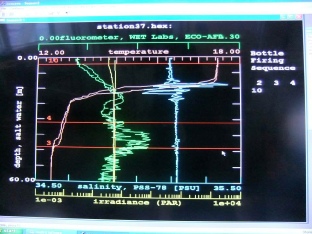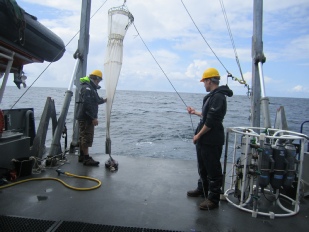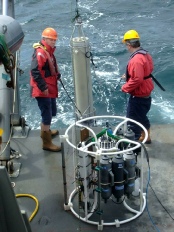Offshore: Methods
Falmouth, 2014
This looks at:
The aim of the offshore sampling was to determine how vertical mixing processes in the waters off Falmouth affect, directly and indirectly, the structure and functional properties of plankton communities. Sampling was completed as a time series at one station over the course of four hours.
The equipment that was utilized was an Acoustic Doppler Current Profile (ADCP) system ,a closing zooplankton net and a Rosette equipped with a CTD, light sensor, fluorometer, transmissometer and 6 Niskin bottles. A Secchi disk, with attached weight, was also deployed after each sampling. An ongoing ADCP scan was done while travelling from the harbour to the station. A PhD student onboard also deployed a marine snow capturing cylinder , as shown in the image below.
At station 38 the CTD was deployed in the water column to perform a yo-
During each sampling the following water properties were measured; temperature, salinity, and depth. Samples were prepared to measure phosphate, silicate, nitrate, dissolved oxygen, and chlorophyll upon return to the lab. All chlorophyll samples were stored in 90% acetone. Lugol’s iodine was added to the phytoplankton samples taken at each depth.



The methods used in the lab were the same as those used to analyse the Estuarine data, for quick jump to that page click here!
28.06.2014
Weather cloudy/grey intermittent rain showers
Cloud Cover: 7/8 Octants